R-13: Difference between revisions
Pbcjohnston (talk | contribs) mNo edit summary |
Pbcjohnston (talk | contribs) mNo edit summary |
||
| (One intermediate revision by the same user not shown) | |||
| Line 1: | Line 1: | ||
[[File:Header 4 New.jpg]] | [[File:Header 4 New.jpg]] | ||
[[File:R-13 underway.jpg|left|500px]] | |||
<div style="text-align: justify;"><span style="color:#00008B">R-13 underway off Hawaii, early 1920's. The exact reason for stowing the deck gun pointed aft is not known. This practice was not used on any other USN submarine. On the forward edge of the conning tower fairwater is a barrel lock bracket where the barrel was secured when not in use. All other boats with a large deck gun had a foldable, triangular shaped barrel lock mounted on the deck forward of the gun. | |||
<small>Photo from the private collection of Ric Hedman</small> | |||
[[File:Red bar sub new.jpg]] | |||
[[File:R-13-1 color.jpg||left|500px]] | [[File:R-13-1 color.jpg||left|500px]] | ||
<div style="text-align: justify;"><span style="color:#00008B"> | <div style="text-align: justify;"><span style="color:#00008B">R-13 crew photo, Pearl Harbor. We know this photo was taken approximately 1924 or a little later by the presence of some of the men wearing the "Qualified in Submarines" patch on their lower right sleeve. The metal Officer's Submarine Warfare pin and the Enlisted cloth patches were created and began being worn in 1924. | ||
Note the one officer in the center of the photo dressed in dungarees but wearing his | Note the one officer in the center of the photo dressed in dungarees but wearing his officer's hat. Officers would do this when work was necessary to keep their dressier uniforms clean. He might be that day's Duty Officer. | ||
The Captain is no-doubt the officer seated on the left wearing his qualification Dolphins and a service ribbon. The officer on the right does not appear to be submarine qualified at the time the photo was taken. | The Captain is no-doubt the officer seated on the left wearing his qualification Dolphins and a service ribbon. The officer on the right does not appear to be submarine qualified at the time the photo was taken. | ||
Some of the men are wearing their stripes on their right sleeve and some on the left sleeve. The right arm rates were deck related jobs. The left arm rates were engineering and electrical jobs. The Navy did away with this system after WW II and placed all the ratings on the left sleeve. The hashmark for time in service was worn on the left sleeve regardless. Until recently a hashmark signified | Some of the men are wearing their stripes on their right sleeve and some on the left sleeve. The right arm rates were deck related jobs. The left arm rates were engineering and electrical jobs. The Navy did away with this system after WW II and placed all the ratings on the left sleeve. The hashmark for time in service was worn on the left sleeve regardless. Until recently a hashmark signified four years of continuous service. Recent changes to the Navy Regulations changed that to three years service. | ||
The lower right corner of the photo is missing. When newspapers cleaned out their archives would many times tear this corner off so they could keep count of dispersed assets and prevent a competitor from using their copy. | The lower right corner of the photo is missing. When newspapers cleaned out their archives would many times tear this corner off so they could keep count of dispersed assets and prevent a competitor from using their copy. | ||
<small>Photo from the private collection of Ric Hedman</small> | <small>Photo from the private collection of Ric Hedman</small> | ||
[[File:Red bar sub new.jpg]] | |||
[[File:R-13 crew pearl harbor upclose1.jpg|left|500px]] | [[File:R-13 crew pearl harbor upclose1.jpg|left|500px]] | ||
<div style="text-align: justify;"><span style="color:#00008B">This and the following four photos are closeups of the original photo above. | |||
<small>Photo from the private collection of Ric Hedman</small> | |||
[[File:Red bar sub new.jpg]] | |||
[[File:R-13 crew pearl harbor upclose2.jpg|left|500px]] | [[File:R-13 crew pearl harbor upclose2.jpg|left|500px]] | ||
<div style="text-align: justify;"><span style="color:#00008B">Closeup #2 of the R-13 crew photo. | |||
<small>Photo from the private collection of Ric Hedman</small> | |||
[[File:Red bar sub new.jpg]] | |||
[[File:R-13 crew pearl harbor upclose3.jpg|left|500px]] | [[File:R-13 crew pearl harbor upclose3.jpg|left|500px]] | ||
<div style="text-align: justify;"><span style="color:#00008B">Closeup #3 of the R-13 crew photo. | |||
<small>Photo from the private collection of Ric Hedman</small> | |||
[[File:Red bar sub new.jpg]] | |||
[[File:R-13 crew pearl harbor upclose4.jpg|left|500px]] | [[File:R-13 crew pearl harbor upclose4.jpg|left|500px]] | ||
<div style="text-align: justify;"><span style="color:#00008B">Closeup #4 of the R-13 crew photo. | |||
<small>Photo from the private collection of Ric Hedman</small> | |||
[[File:Red bar sub new.jpg]] | |||
[[File:R-13 crew pearl harbor upclose5.jpg|left|500px]] | [[File:R-13 crew pearl harbor upclose5.jpg|left|500px]] | ||
<div style="text-align: justify;"><span style="color:#00008B">Closeup #5 of the R-13 crew photo. | |||
<small>Photo from the private collection of Ric Hedman</small> | |||
[[File:Red bar sub new.jpg]] | [[File:Red bar sub new.jpg]] | ||
| Line 29: | Line 65: | ||
The tent to the right is to keep rain out of the open hatch. | The tent to the right is to keep rain out of the open hatch. | ||
The sailor is wearing blues so that means the photo was taken between September 1 and May 31, otherwise he would be wearing summer | The sailor is wearing blues so that means the photo was taken between September 1 and May 31, otherwise he would be wearing summer whites. He has a white garrison belt and the holster for a .45 caliber, M1911A1 pistol can be seen near his right arm. The belt holds closed his heavy wool Peacoat and he is wearing a white hat under the hood of his raincoat. He is also wearing galoshes over his shoes. All in all, a nasty wet day on the Thames River. | ||
<small>Photo | <small>Photo from the private collection of Ric Hedman.</small> | ||
[[File:Red bar sub new.jpg]] | |||
[[File:R-13 sub school.jpg|left|500px]] | [[File:R-13 sub school.jpg|left|500px]] | ||
<div style="text-align: justify;"><span style="color:#00008B">A fine, high resolution photo of R-13 underway in the Thames River between New London and Groton CT., December 9, 1940. The photo was taken from the Thames River Bridge that connects New London and Groton. At this point in her career R-13 was assigned to the Submarine School in Groton, running training missions for students in the Atlantic. A group of students is lined up here on the gun deck under the watchful eye of an officer. The dome-like object near the student's feet is the forward rescue/messenger buoy, part of the safety upgrades applied to all boats in the early 1930's. It is fairly unusual to have the bow planes rigged out while still in the river. Perhaps training was being conducted on how to do that. | |||
<small>Photo from the private collection of Ric Hedman.</small> | |||
[[File:Red bar sub new.jpg]] | |||
[[File:R-13 sub school upclose1.jpg|left|500px]] | [[File:R-13 sub school upclose1.jpg|left|500px]] | ||
<div style="text-align: justify;"><span style="color:#00008B">A closeup of the bridge. It would be unusual to pack five men on this small bridge. Usually the maximum would be three. This is most likely a staged photo. | |||
<small>Photo from the private collection of Ric Hedman.</small> | |||
[[File:Red bar sub new.jpg]] | |||
[[File:R-13 sub school upclose2.jpg|left|500px]] | [[File:R-13 sub school upclose2.jpg|left|500px]] | ||
<div style="text-align: justify;"><span style="color:#00008B">A closeup of the forward deck. The long plank is actually the boat's gangway (brow). The hatch to the torpedo room is open. A censor has blanked out the JK/SC sonar head. | |||
<small>Photo from the private collection of Ric Hedman.</small> | |||
[[File:Red bar sub new.jpg]] | |||
[[File:R-13 sub school upclose3.jpg|left|500px]] | [[File:R-13 sub school upclose3.jpg|left|500px]] | ||
<div style="text-align: justify;"><span style="color:#00008B">A closeup view of the tip of the bow, showing details of the bow planes and how the towing chain/hawser was secured to the deck. Note the recesses on either side of the bow behind the bow planes. This is where the bow planes were stowed when retracted. | |||
<small>Photo from the private collection of Ric Hedman.</small> | |||
[[File:Red bar sub new.jpg]] | |||
<center>[[R-class|Return to the R-class page]] | [[Submarine Classes|Return to the Submarine Classes page]]</center> | |||
[[File:Red bar sub new.jpg]] | [[File:Red bar sub new.jpg]] | ||
<center> | <center> | ||
Latest revision as of 13:15, 22 September 2023
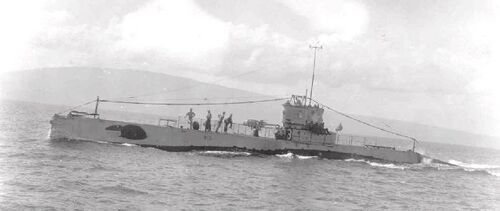
Photo from the private collection of Ric Hedman
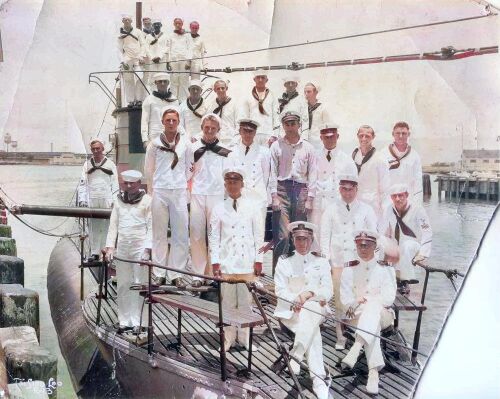
Note the one officer in the center of the photo dressed in dungarees but wearing his officer's hat. Officers would do this when work was necessary to keep their dressier uniforms clean. He might be that day's Duty Officer.
The Captain is no-doubt the officer seated on the left wearing his qualification Dolphins and a service ribbon. The officer on the right does not appear to be submarine qualified at the time the photo was taken.
Some of the men are wearing their stripes on their right sleeve and some on the left sleeve. The right arm rates were deck related jobs. The left arm rates were engineering and electrical jobs. The Navy did away with this system after WW II and placed all the ratings on the left sleeve. The hashmark for time in service was worn on the left sleeve regardless. Until recently a hashmark signified four years of continuous service. Recent changes to the Navy Regulations changed that to three years service.
The lower right corner of the photo is missing. When newspapers cleaned out their archives would many times tear this corner off so they could keep count of dispersed assets and prevent a competitor from using their copy.
Photo from the private collection of Ric Hedman
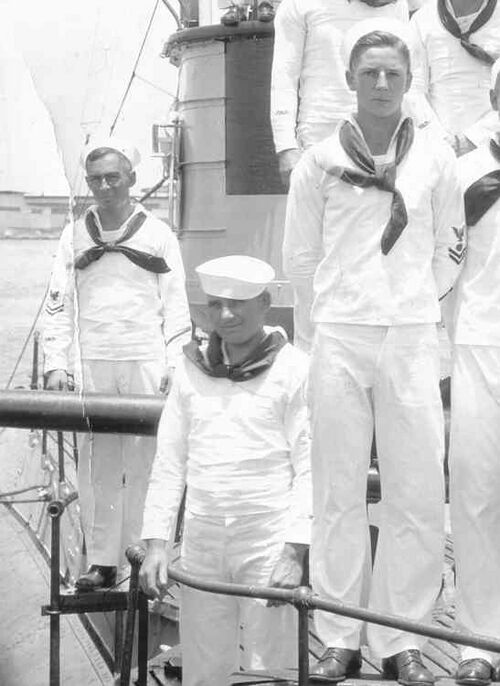
Photo from the private collection of Ric Hedman
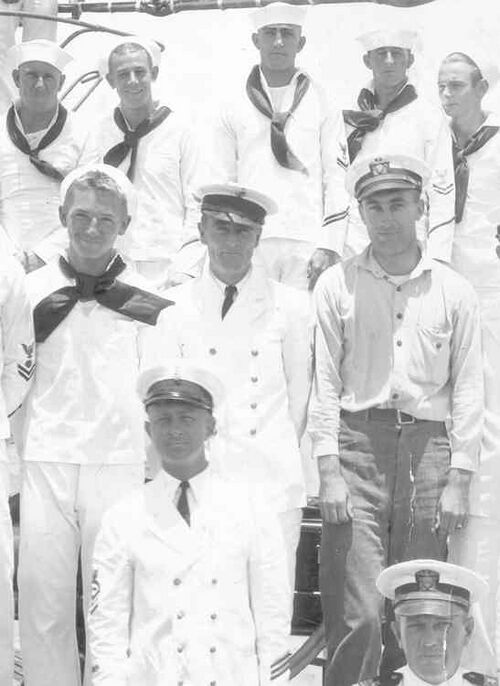
Photo from the private collection of Ric Hedman
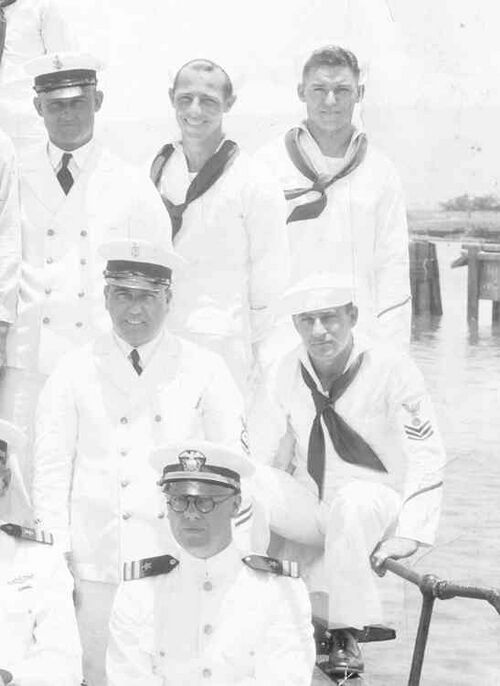
Photo from the private collection of Ric Hedman
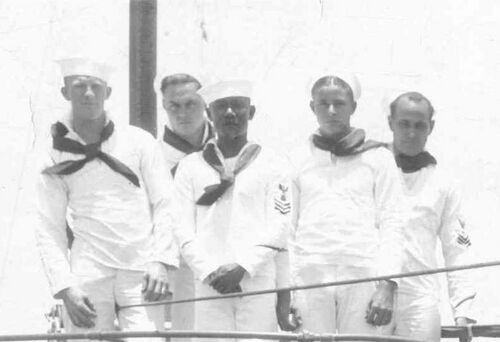
Photo from the private collection of Ric Hedman
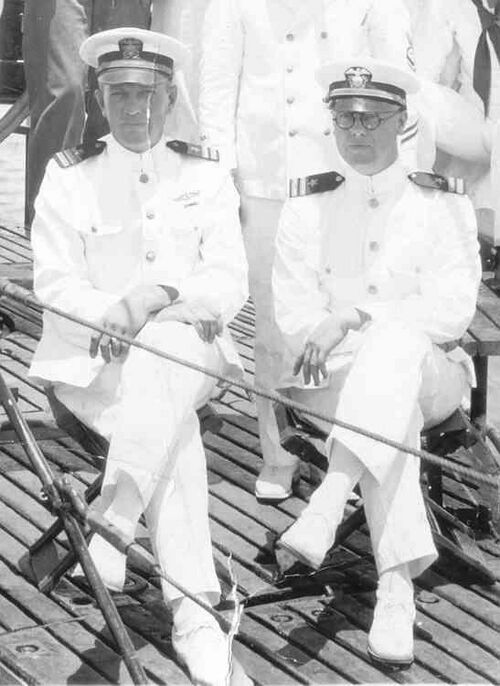
Photo from the private collection of Ric Hedman
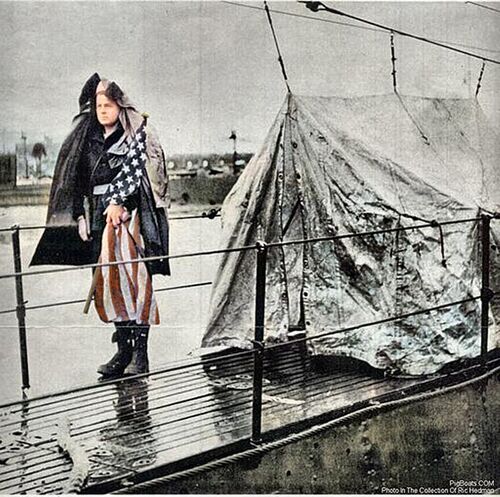
At 8 AM a signal, usually a bugle call followed by the playing of the National Anthem, is given at the base and all vessels raise the American flag. All personnel are to stop what they are doing and face the closest visible flag and salute as the flag is raised up the flagpole. In this case the flag is already attached to the flag staff and the man is waiting for the signal to place the staff into its holder. The event is officially called "Colors".
The tent to the right is to keep rain out of the open hatch.
The sailor is wearing blues so that means the photo was taken between September 1 and May 31, otherwise he would be wearing summer whites. He has a white garrison belt and the holster for a .45 caliber, M1911A1 pistol can be seen near his right arm. The belt holds closed his heavy wool Peacoat and he is wearing a white hat under the hood of his raincoat. He is also wearing galoshes over his shoes. All in all, a nasty wet day on the Thames River.
Photo from the private collection of Ric Hedman.
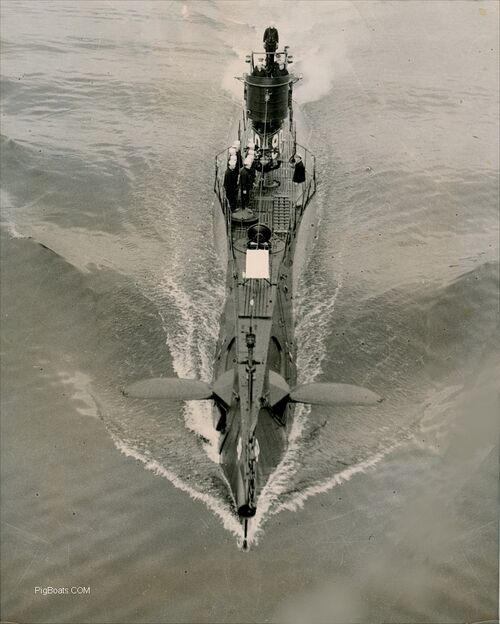
Photo from the private collection of Ric Hedman.
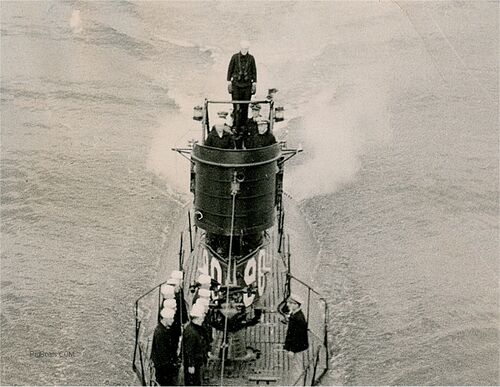
Photo from the private collection of Ric Hedman.
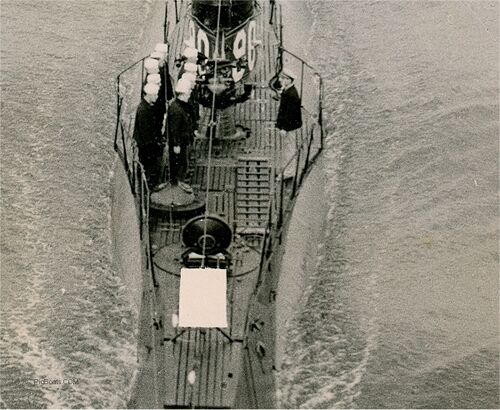
Photo from the private collection of Ric Hedman.
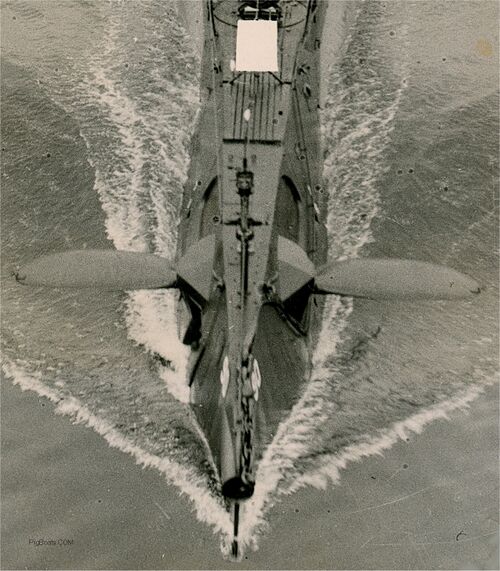
Photo from the private collection of Ric Hedman.
Page created by:
Ric Hedman & David Johnston
1999 - 2023 - PigBoats.COM©
Mountlake Terrace, WA, Norfolk, VA
webmaster at pigboats dot com
